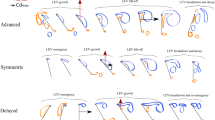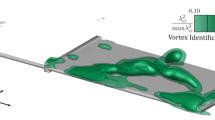Abstract
This paper focuses on one of the most prominent flow features of the hovering rotor wake, the close interaction of the tip vortex with a following blade. Such vortex interactions are fundamental determinants of rotor performance, loads, and noise. Yet, they are not completely understood, largely due to the lack of sufficiently comprehensive experimental data. The present study aims to perform such comprehensive measurements, not on hovering helicopter rotors (which hugely magnifies test complexity) but using fixed-wing models in controlled wind tunnel tests. The experiments were designed to measure, in considerable detail, the aerodynamic loading resulting from a vortex interacting with a semi-span wing, as well as the wake resulting from that interaction. The goal of the present study is to answer fundamental questions such as (a) the influence of a vortex passing below a wing on the lift, drag, tip vortex, and the wake of that wing and (b) the strength of the forming tip vortex and its relation to the wing loading and/or the tip loading. This paper presents detailed wing surface pressure measurements that result from the interaction of the wing with an interacting vortex trailing from an upstream wing. The data show large lift distribution changes for a range of wing–vortex interactions including the effects of close encounter with the vortex core. Significant asymmetry in the vortex-induced lift loading was observed, with the increase in wing sectional lift outboard of the interacting vortex (closer to the tip) being much smaller than the corresponding decrease inboard of the vortex.





















Similar content being viewed by others
References
Bhagwat MJ, Ramasamy M (2012) Effect of tip vortex aperiodicity on measurement uncertainty. Exp Fluids 53(5):1191–1202
Caradonna F, Tung C (1981) Experimental and analytical studies of a model helicopter rotor. Vertica 5:149–161
Ham ND (1975) Some conclusions from an inverstigation of blade-vortex interaction. J Am Helicopter Soc 20(4):26–31
Kitaplioglu C, Caradonna FX (1994) Aerodynamics and acoustics of blade-vortex interaction using an independently generated vortex. In: American Helicopter Society Aeromechanics Specialists’ Conference, San Fransisco, CA
Komerath NM, Smith MJ, Tung C (2011) A review of rotorwake physics. J Am Helicopter Soc 56(2):022006-1–022006-19
McAlister KW, Takahashi RK (1991) NACA 0015 wing pressure and trailing vortex measurements. Tech Rep TP 3151, NASA
Ramasamy M, Pete AE, Bhagwat MJ, Caradonna FX (2014) An experiment to simulate the airloads andwake typical of a hovering rotor. In: American Helicopter Society Aeromechanics Specialists’ Conference, San Fransisco, CA
Wittmer KS, Devenport WJ (1999) Effects of perpendicular blade–vortex interaction, part 1: turbulence structure and development. AIAA J 37(7):805–812
Wittmer KS, Devenport WJ, Glegg SA (1999) Effects of perpendicular blade–vortex interaction, part 2: parametric study. AIAA J 37(7):813–817
Acknowledgments
This test with its unusual test setup and high density instrumentation presented some unique challenges, and would not have been possible without the support of our outstanding tunnel crew—Steve Nance, Brian Chan, Bruce Gesek, Gary Buob, Hank Schwoob, Bill Peneff, Perry Kavros, and their leader, Nili Gold. Special thanks to Sam Gunatileka for data acquisition programming that well exceeded our expectations. A very special recognition is due to Jim Scott of the NASA Ames model manufacturing branch, who conceived the basic wing and instrumentation design and executed the fabrication of this one-of-a-kind model with extraordinary imagination and skill. The authors would also like to thank Jon Bader of the NASA Ames Wind Tunnel Support Branch for supporting us in the use of their Task sting balance for this test.
Author information
Authors and Affiliations
Corresponding author
Appendices
Appendix 1: Blockage and induced angle corrections
The VG trolley was responsible for a noticeable blockage effect. An early indication of the presence of this blockage was that the required tunnel power was noticeably reduced with the removal of the trolley. Furthermore, the flow over the VG trolley also introduced an induced flow angle at the downstream wing. Present data must be corrected for this blockage and incidence angle effects. However, the lift deltas caused by vortex interactions are not a strong function of wing incidence. Therefore, the behavior of the wing–vortex interaction is not significantly altered by this interference.
It was found that when the trolley (whether or not the VG is mounted) is three feet upstream of the wing, it is responsible for an effective upwash angle of about 0.5°. The present paper reports data at this separation distance, and the wing incidence angle was corrected for this induced angle, i.e., the stated wing incidence \(\alpha _\mathrm{w}=7^{\circ }{}\) comprised of 6.5\(^{\circ }\) geometric angle of attack as measured by the inclinometer mounted at the wing root. This induced upwash at the wing decreased as the trolley moved upstream relative to the wing. When the trolley was 9 ft upstream of the wing, almost no induced upwash was experienced by the wing. This was verified by eventually acquiring data with the trolley removed.
Total lift force measured by the balance as a function of wing incidence angle is shown in Fig. 22 for several configurations including the VG trolley located at several locations upstream of the wing, measurements with the trolley removed, and also measurements with the inner rails also removed. Large variations are seen between these different configurations. Two simple corrections are applied to the measurements. The first is a zero lift angle correction to account for the induced flow due to the VG trolley. The second is a simple blockage correction based on the frontal area of the faired trolley of 4.5 in. tall and 6 ft wide. This corresponds to a blockage area ratio of \(\epsilon =3.2\,\%\), and the dynamic pressure is corrected to reflect the blockage effect as \(q_c=q/\epsilon ^2\). The results shown in Fig. 22 are shown again in Fig. 23 including the two corrections. In this latter case, all the results nominally collapse to a single curve showing a linear lift coefficient with angle of attack. This suggests that such a simple correction may be sufficient for comparing the measurements with computations without modeling the tunnel and the test setup to minimize computational costs and meshing complexities.
Appendix 2: Effect of flow fence near wing root
The tunnel wall had a moving slot to allow the wing to be attached to the balance mounted outside the tunnel walls on a moving trolley. The slot was small, extending only about an inch above the wing surface to accommodate wing incidence angle changes. Previous work by McAlister and Takahashi (1991) has shown that even such a small opening can drive flow along the wing span, which can significantly alter the wing lift not only near the root but also over the entire wing span. To minimize such flow effects, a circular flow fence was mounted on the wing at 2.5 in. from the tunnel wall. Initial design used an 18-in. diameter circular fence. However, wing lift obtained from surface pressure measurements showed some loss of lift near the wing root even with this flow fence. This led to a design of a much larger flow fence with 48 in. diameter. The spanwise wing lift coefficient distributions measured with these two fences along with that without any flow fence are shown in Fig. 24. In the absence of the fence, there is a large decrease in sectional lift coefficient near the wing root at the 8-in. span station. As the size of the fence increases, the inboard section lift recovers to a level nearly equal to that at the 30-in. station close to the mid-span. It is interesting to note that for both the small fence and the no fence cases, the wing lift decreases over entire span, although the decrease is much smaller away from the root.
Rights and permissions
About this article
Cite this article
Bhagwat, M.J., Caradonna, F.X. & Ramasamy, M. Wing–vortex interaction: unraveling the flowfield of a hovering rotor. Exp Fluids 56, 19 (2015). https://doi.org/10.1007/s00348-014-1893-3
Received:
Revised:
Accepted:
Published:
DOI: https://doi.org/10.1007/s00348-014-1893-3







